
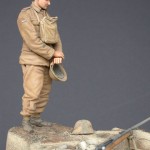
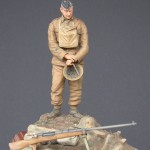
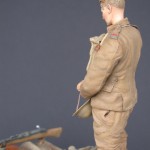
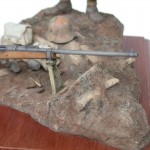
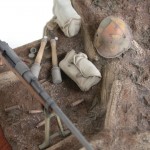
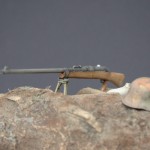
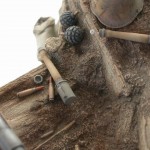
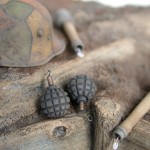
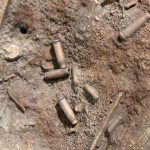
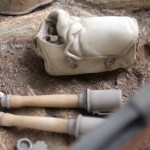
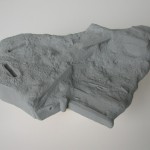
Private, 4th Battalion Tank Corps 1918 with Captured 13 mm Mauser Anti-Tank Rifle
- Scale / Maßstab: 1:16
- Material: Resin (figure), Model Plaster (base) / Resin (Fugur), Modell-Gips (Sockel – synethetische, kunststoffveredelte Gießmasse)
- Parts / Teile: 30
- Infosheet / Infoblatt: English
- Code: 10TFa
Contents / Inhalt:
- Figure (8 parts) / Figur (8 Teile)
- Alternative Head with Glengarry / Alternativ-Kopf mit Glengarry-Mütze
- Small Box Respirator Bag / Small Box Gastasche
- British Steel Helmet Mk.1 / Bt. Stahlhelm Mk.1
- Mauser Tank Rifle M1918 (3 parts) / Tankgewehr Mauser M1918 (3 Teile)
- Standard MG 08/15 Bipod / MG08/15 Zweibein
- Ammunition Holder / Munitionstashe
- 6 x 13mm Anti-Tank Ammunition / 6 x 13mm Tankgewehrpatronen
- 6 x Empty 13mm Mauser T-Gewehr Cartridges / 6 x Leere 13mm Mauser T-Gewehr Patronen
- Mauser C96 Pistol
- 2 x Ball Grenades M1913 / 2 Stck. Kugelhandgranate M 1913 a. A. (alte Art – old type)
- Stick Grenades M.15 / Stielhandgranaten M.15
- Multi Charge Grenade (2 parts) / Geballte-Ladung (2 Teile)
- Steel Helmet M.16 / Stahlhelm M.16
- Figure Base / Figur-Sockel
Below are photos of my own painted figure, with the wooden plinth cut out to enable the German trench revetment supplied to be extended further downwards. The last part of the trench revetment with shelf is not included in this figure diorama.
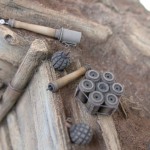
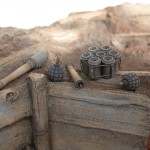
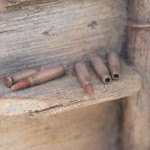
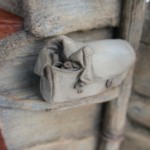
Extracts from the Infosheet with this figure:
Mauser Tank Rifle / Tankgewehr Mauser M1918: Designed and produced in the Mauser factory at Oberndorf as a short-term answer to the new tank problem on the Western Front. This single shot bolt-action weapon was the world’s first anti-tank rifle. Total length approx. 170 cm, weight together with the 08/15 MG bipod attached 17.1 Kg. Nicknamed the Elefantenbüchse, or Elephant-rifle at the Mauser factory this weapon was too heavy, the recoil too strong and the penetration when used against armour insufficient. (Most of the allied tanks were stopped by direct or indirect artillery fire).
In action these rifles were used either with the 08/15 MG bipod (the original bipod designed for this weapon was seldom employed) or mainly without, the rifle being placed on top of the trench wall/parapet. Due to the considerable recoil and when practical the gunners would change over roles after every 2 – 3 rounds, engaging the enemy armour at as close a range as possible.
In the German Army instruction manual for the rifle it is stated that both the gunner No. 1 and 2 should be chosen for their size and strength. They should be determined, cool-headed and also good shots. The employment of the T-Gewehr in groups of 3 or individually depends on the tactical situation and lay of the ground. The use of the T-Gewehr in combination with the MG 08 or MG 08/15 using special armoured piercing SmK rounds (SmK – Stahlmantel mit Kern) increases the chances of success. At the front end of the bolt are the 3 discharge vents, which enabled excess gasses to be released during firing. Colour: the wooden stock and pistol grips were of a dark wood. All other parts were a dark gun- metal. The bolt, especially the handle were generally shinier. 13mm case – brass. Bullet head – dark copper.
Note: a common characteristic on original guns are the small indents/damages on the left hand side of the wooden butt (just behind the narrow part), caused by the rim of the gunner’s steel helmet denting the rifle on recoil – this has been reproduced on the model rifle. The separate bolt can either be built in the open or closed position. Either separate the bolt and fix accordingly, or even better, drill out the rear part of the breech (2mm hand drill) – here a small central indent has been placed for assistance. If possible and if the drill bit is long enough, drill up into the rear of the barrel a few mms as well. This will enable the bolt to function as in the original. The 13mm rounds supplied with the set will in fact fit into the breach.
Tip: in order to achieve a smoother function of the bolt moving in and out of the chamber, one can apply some sanded down pencil lead with an old paintbrush. This will not only lubricate the parts, but also give it a natural shiny appearance, just like the original.
Mauser C96 Pistol / Mauser Pistole C96: At the outbreak of hostilities the 08 Pistol long barrel version (Luger – the Germans never called this weapon the Luger – this is an anglicised name) could not be issued quickly enough to artillery and auxiliary units, so the German Army purchased a large number of C96s, which also had the extended wooden butt. Although originally put through trials 1 year before the war, the C96 was not taken on. The calibre is 7.63, with a 10 round capacity in the magazine, which was later changed by the Mauser Company in 1916 to the standard 9mm. In order to avoid mix-ups with different ammunition, a figure 9 was carved into the pistol grip and painted out in red. The tool on the side of the leather holster is the cleaning rod with a wooden handle. The small pocket at the front holds a spare ammunition strip. Normally, the pistol is carried attached to the belt, on the left hand side. A sling was also supplied to enable the person to wear the pistol over the left shoulder with the weapon resting on the right hip.
Although originally intended for issue to artillery units these pistols found their way into many other parts of the army and were particularly popular with soldiers and NCOs serving in the front line units (officers would normally have smaller pistols). Also, these pistols were well liked with Stormtrooper units for their reliability and robustness. Colour: leather supporting rig – natural leather, wooden shoulder stock/holster – brown wood, gunmetal – dark metal colour.
Note: the small ring attached to the bottom of the pistol grip can be hollowed out.
Stick Grenade / Stielhandgranate M.15: The second type of German stick grenade to be issued (in greater numbers from 1916 onwards). The turned wooden handle would have the fuse duration stamped on one side, along with the makers name and production date. This grenade had the advantage of a screw cap, covering the porcelain ball and pulls cord igniter-system inside, keeping it dry and free from dirt. Most stick grenades were set with a 5.5 or 7-second time delay. The cap crown has 8 knurled indents to enable a better grip in wet/muddy conditions, or when wearing cloves. The metal clip on the side of the explosive charge is for attaching to equipment etc. On some original photos it can be seen that the screw caps have already been removed, ready for instant use if needed. The original master model was made using a fine grain wood to reproduce the surface of the handle. Colour: Metal parts – green/grey. Wooden stick/handle – untreated wood starts turning grey after a length of time when exposed to the elements.
Note: with a bit of care and a thin, sharp blade it is possible to hollow out the gap behind the clip and the explosive charge, not forgetting to leave the bottom part of the clip still attached.
Multi Charge Grenade / Geballte-Ladung: Made out of 7 stick grenades and generally used against enemy dugouts and strongpoints. These multi charges were made by the troops themselves at the front. Original photos show the middle grenade surrounded with 6 grenade heads without the handles, secured by several loops of wire, tied under the metal belt clips. The shape of the grenade heads means that they do not sit snug together on account of the protruding bottom rim. Due to moulding techniques the areas in between the grenade heads are filled out. Colour: Metal parts – green/grey. Wooden stick/handle – untreated wood starts turning grey after a length of time exposed to the elements.
Note: with a bit of care and a thin, sharp blade it is possible to hollow out the gaps behind the clips and the explosive charge heads, not forgetting to leave the bottom part of the clip still attached.
Ball Grenade M 1913 / Kugelhandgranate M 1913 a. A. (alte Art – old type): This grenade was made out of cast-iron with large external fragmentation segments. The friction delay fuse was activated by pulling the twisted priming wire – for this there was an extra wrist lanyard with a snap hook. Later types of Kugelhandgranatn had a more simplified outer casing and were sometimes issued painted green. Colour: Grenade – mainly black. Fuse – brass. A twisted priming wire can be constructed using a thin wire or similar and inserted into a small hole drilled at the top of the fuse.
 An deutschsprachige Interessenten:
Sie können mich per eMail oder Telefon auch gerne auf deutsch kontaktieren. Ortsbesuch ist nach Absprache möglich.
An deutschsprachige Interessenten:
Sie können mich per eMail oder Telefon auch gerne auf deutsch kontaktieren. Ortsbesuch ist nach Absprache möglich.
